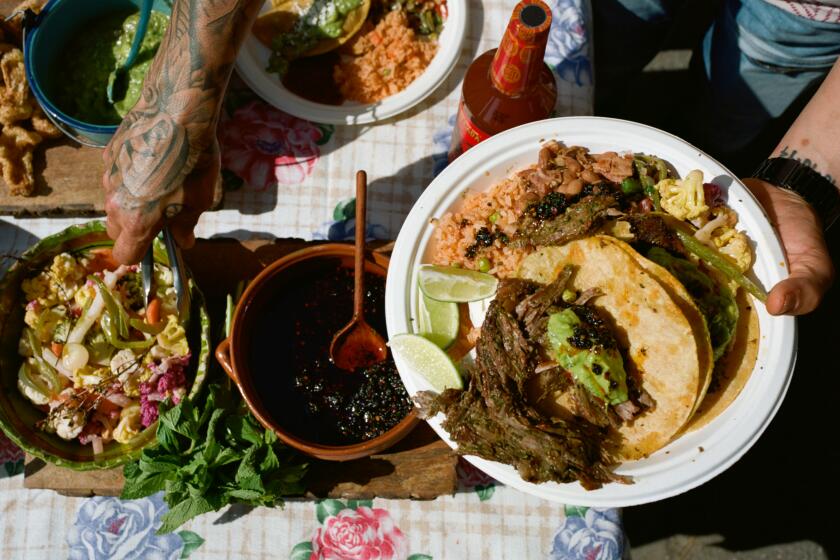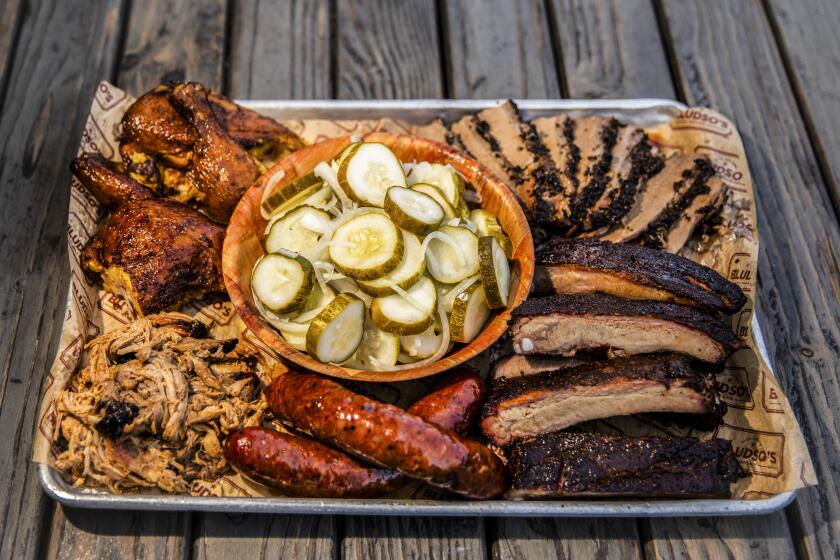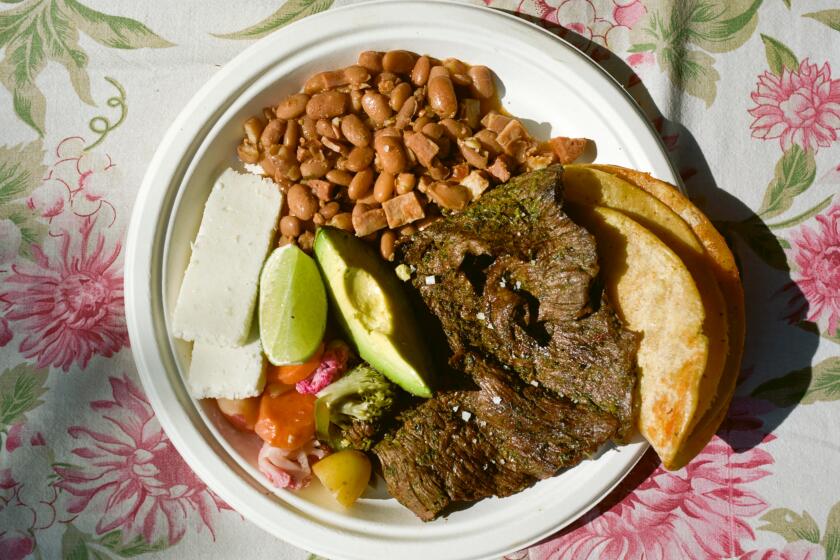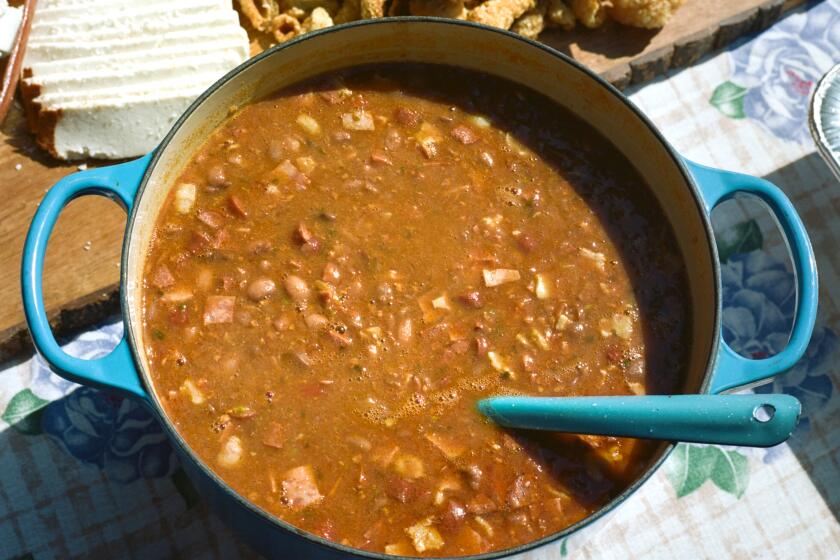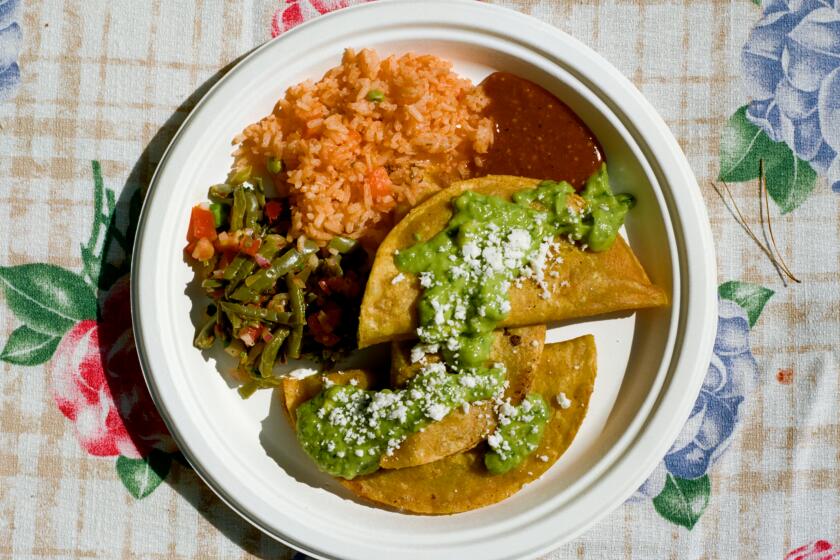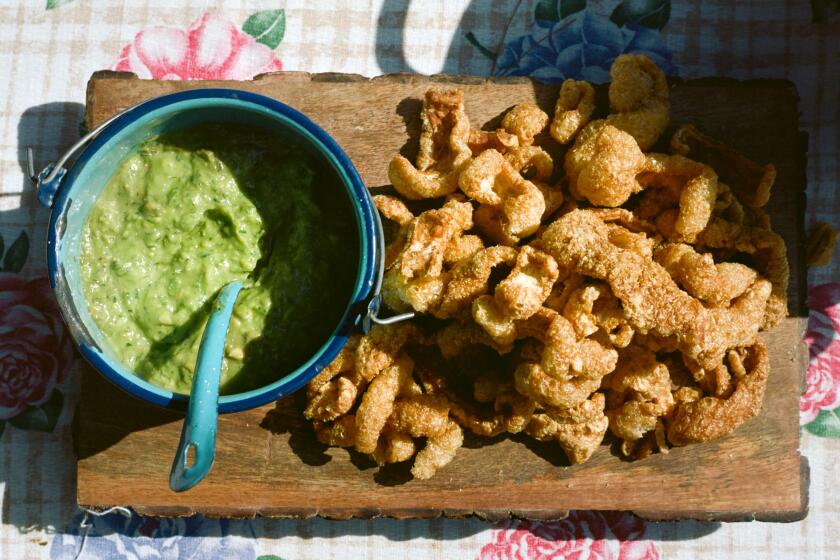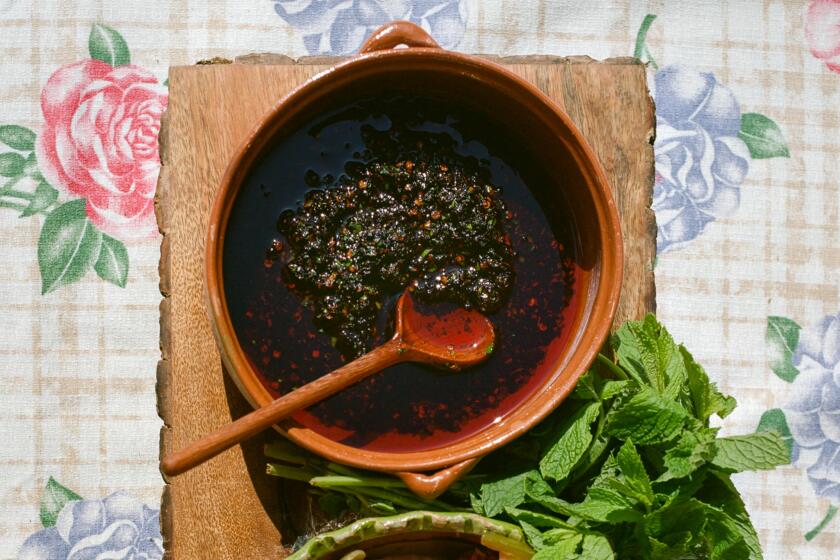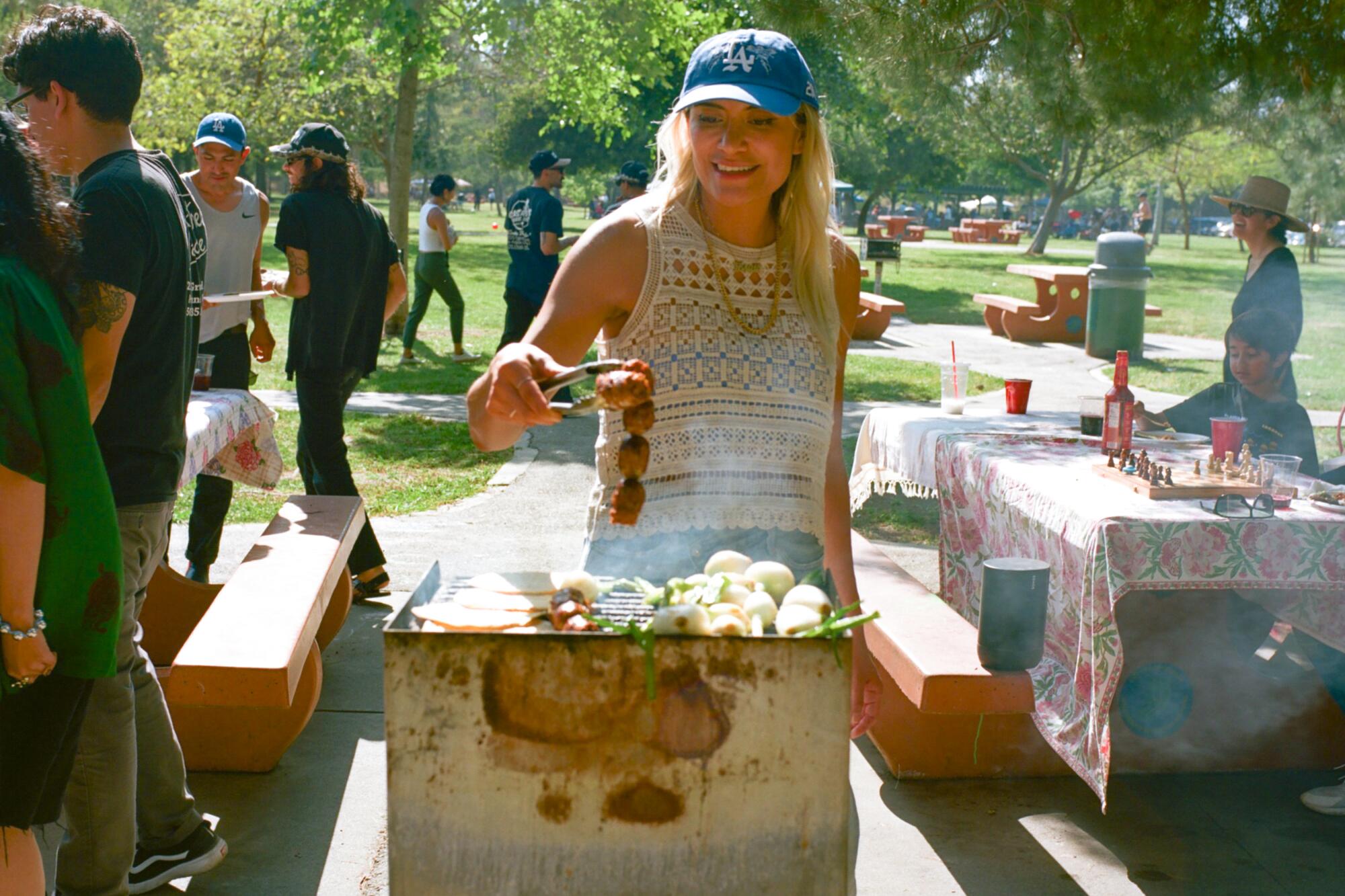
- Share via
Many people hear the word “asada” and think carne asada tacos or burritos, or carne asada plates with rice and beans at their favorite home-style Mexican restaurant. But Bricia Lopez and Javiar Cabral, along with countless other Angelenos, know that asada transcends the confines of a taco.
In “backyards across Southern California, an asada represents more than just meat,” the two say in the introduction to Lopez’s recently published book, “Asada: The Art of Mexican-Style Grilling.” “It means family, friends, memories, great music, cold drinks, good times and the community you’ve built — all centered on the promise of juicy grilled meat and ... fixings that remind you of your upbringing.” Especially if your upbringing includes family barbecues in the public parks and backyards of Los Angeles.
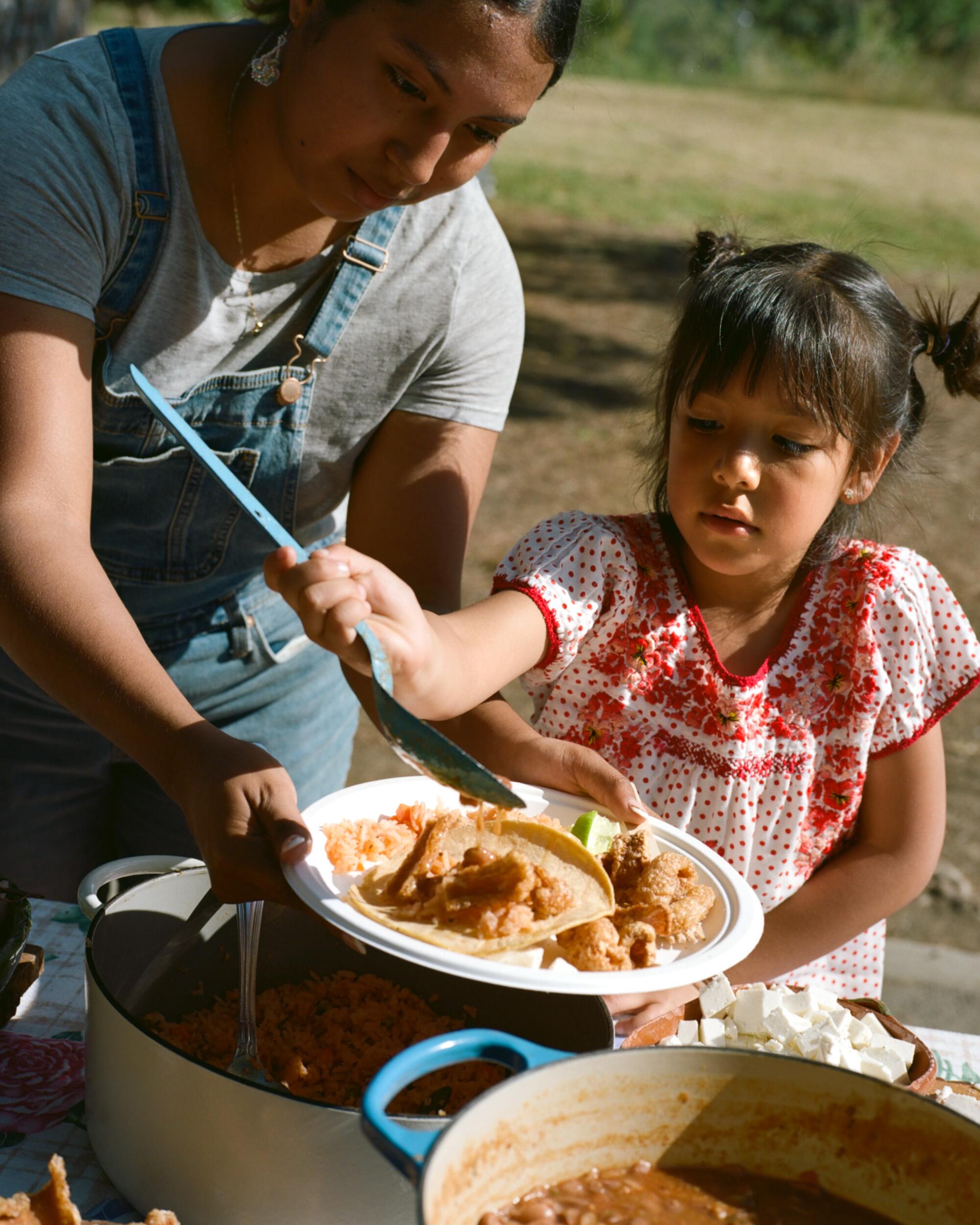
“The smell of asada,” write Lopez and Cabral, “is an invisible cloud of joy that forever lingers around the streets of Los Angeles.”
That cloud of joy, the scent of sizzling meat, sweet and tart from its marinade, is what welcomes the family and friends Lopez has gathered on a recent Saturday at L.A.’s Ernest E. Debs Regional Park for an afternoon asada.
Japanese yakitori. Middle Eastern kebab. Argentine and Chilean asados. Thai satays. Korean barbecue. All contribute to the great cacophony of how we cook with fire in Los Angeles.
Kids giggle inside a bounce house Lopez has set up, jumping almost in time to the thumping beats of music that provide the asada’s soundtrack. At one of the picnic tables, Lopez’s son has a chess game going as his mom tends the grill. Friends new and old arrive throughout the afternoon, grabbing just-made tacos — some with gorgeously charred meat, others with fingerling potatoes and rajas — and filling their plates from a table that holds a pot of meaty charro beans in broth, several salsas, guacamole, nopalitos (cactus paddles) and an arrangement of Oaxacan cheese and chicharrón, the crisp pork skin taking the place of crackers.
“We open the book with our chicharrón and cheese platter, which I think puts to shame any charcuterie board or butter board,” Lopez tells me when I interview her and Cabral at the Los Angeles Times Festival of Books in April, “because Mexico has such an array of beautiful cheeses.”
Those cheeses often appear on the memelas, tlayudas, quesadillas and botana platters served at Guelaguetza, the Oaxacan restaurant (and winner of the 2021 L.A. Times Gold Award) that Lopez runs in Los Angeles’ Koreatown with her siblings. What’s not on Guelaguetza’s Oaxaca-focused menu is a straight-up carne asada plate.
“Carne asada as a pastime in Mexico took off in the 1950s, specifically in the northern and northeastern regions of Sonora and Nuevo León,” Cabral and Lopez say in their book. Over time, the asada way of life took root in Los Angeles. As L.A. kids, both grew up with asada as integral parts of their childhoods, as important as Dodgers baseball.
The idea for the book, the pair’s second after 2019’s “Oaxaca: Home Cooking From the Heart of Mexico,” emerged in 2020, when the pandemic prevented Lopez from hosting her annual Fourth of July asada.
Most years, Lopez says, “My family comes over and we do the all fixings and meat and it’s just such a fun time. My husband gets incredible fireworks. It’s like Disneyland in my backyard with the best food. So when we couldn’t get together that year, my siblings asked me for the recipes. They wanted to do their own versions for their families. It was at that moment that I thought this is the book that I want to write — to capture the carne asada culture that L.A. is known for and that is second nature to Latinos and Mexicanos here in L.A. It’s so second-nature that we forget how special it is.”
For Cabral, who is editor of the food, culture and news site L.A. Taco, the asada idea felt exactly right. “I firmly believe that asada is the best taco out there. Sorry, al pastor! There’s just something primal about fire-grilled meat.”
One of the most appealing things about the meat that is the centerpiece of an asada is that, as Lopez and Cabral say in their book, it’s “beautifully unpretentious.”
Whether it’s Texas, Memphis, Carolina or some hybrid style of barbecue you crave, here are the best places for delicious smoked meats in L.A.
Flap steak or ranchera — what Lopez calls the “king cut of carne asada” — is the most popular and affordable asada pick. But an asada can handle many kinds of meats, from skirt steak (or arrachera) to rib-eye, chicken, lamb, Spanish and Mexican chorizo, pork chops and even pricy Wagyu beef.
“I think this book coincides with the buying power of a lot of Latinos who are getting older and have a little more income,” Cabral says. “They want to buy nice meat. At L.A. Taco we did a rundown of carnicerías and found several that now specialize in prime-quality, Wagyu-quality meat.”
Of course, he adds, “you can buy any quality of meat and with the magic of one of our marinades you’ll have something great.”
“Listen,” Lopez says, “I love meat. I get down with everything. It’s not about elevating the meat; it’s a complimenting and having it shape shift to your taste buds. Someone might say, ‘How dare you put lime on your Wagyu.’ But I say, ‘I’m Mexican, I put lime and limón on everything, every day. Let me be.’”
Because as long as you have good friends and good food at an asada, almost anything goes.
Five recipes from “Asada: The Art of Mexican-Style Grilling”
Arrachera Verde
Frijoles Charros in Broth
Fingerling and Raja Tacos
Blended Guacamole
Salsa de morita seca
More to Read
Eat your way across L.A.
Get our weekly Tasting Notes newsletter for reviews, news and more.
You may occasionally receive promotional content from the Los Angeles Times.
